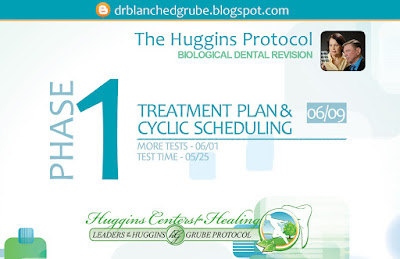Phase One of The Huggins-Grube Protocol – Treatment Plan and Cyclic Scheduling
Your test results are in! We know your personal nutritional profile and your biocompatibility parameters. We also know the electrical charges of your fillings.
Now, it’s time to work up your treatment plan. Think of it like this: your map application on your smartphone tells you the possible routes for getting from wherever you are to wherever you want to be. The route you end up taking, however, with its stops and starts, detours and visits, is the particular path you actually take to get there.
Making the Protocol a Custom Fit
It’s the same thing with the Protocol. Its various components and steps are one thing; how we adapt them to your specific needs is quite another. You know those clothes marked “one size fits all,” where “all” is really “none”? Well, this is definitely a case where one size – that is, one practical application of our Protocol – definitely does not fit all!
“What are some of these planning variables, Dr. Blanche?” Well, since you’re having amalgam removed from your teeth, we’ve got to replace it with something else, right? We can’t leave holes in your head (literally). So, do you want a composite filling, or maybe a gold one? If we also have to remove teeth in the revision process, do you prefer a fixed bridge or a removable one? Then, there’s the question of anesthesia. Do you prefer conscious sedation or just a local anesthetic? See? All of these variables need to be determined to get the best fit for you.
The 7-14-21 Day Cycles
There’s more. Now that we’ve determined what we’re going to do for you, it’s time to determine when. It’s impossible to exaggerate the importance of this. Over the years, we’ve observed the responses of many patients with respect to appointment length. More importantly, we’ve studied the scheduling intervals between successive appointments, in conjunction with a patient’s immune cycles.
The science behind this is fascinating, but it’s more than we can cover in this format. Suffice it to say that our bodies run on many overlapping cycles. For instance, there are:
· the numbers of hours you sleep
· when you go to bed
· when you get up in the morning
· when you eat your first meal of the day
· your menstrual cycles (for women)
· how long your red blood cells live
· how long your white blood cells live
Whew! I don’t know about you, but that’s a lot of different cycles. Now, from the dental point of view, toxic exposure initiates cycles of immune activity, which likewise activate other immune or endocrine activity. Yes, the human body, in spite of how simply and smoothly it operates, is incredibly complex.
So, what does this mean for you, bottom-line? It means that any successive dental revision work done before your immune system has had a chance to “reboot” can cause major health problems. If you picture a runner who hurts his ankle and then starts running again before the ankle is healed, then you’ve got a pale image of what I’m talking about. That’s because when it’s a question of your immune system, there’s a lot more than a damaged joint at stake. Quite literally, it’s you who are at stake. Immunity is no joke, and a damaged immune system is a tragedy.
End of Phase One
With that, we’ve completed our review of the first phase of our Protocol for patient protection. We’ve covered a lot of ground together, and there’s been a lot to absorb. Don’t worry: we’re not going anywhere, and this is just the beginning of our discussion of everything we do to protect you and your health – which, by now, you certainly realize includes much more than a nice smile.
We’ll be taking a break next week from our discussion of the Protocol to tell you about an awesome new product we’ve discovered. So, be sure to check back next Monday to read all about it.
Until then, keep well!
Dr. Blanche


No comments:
Post a Comment